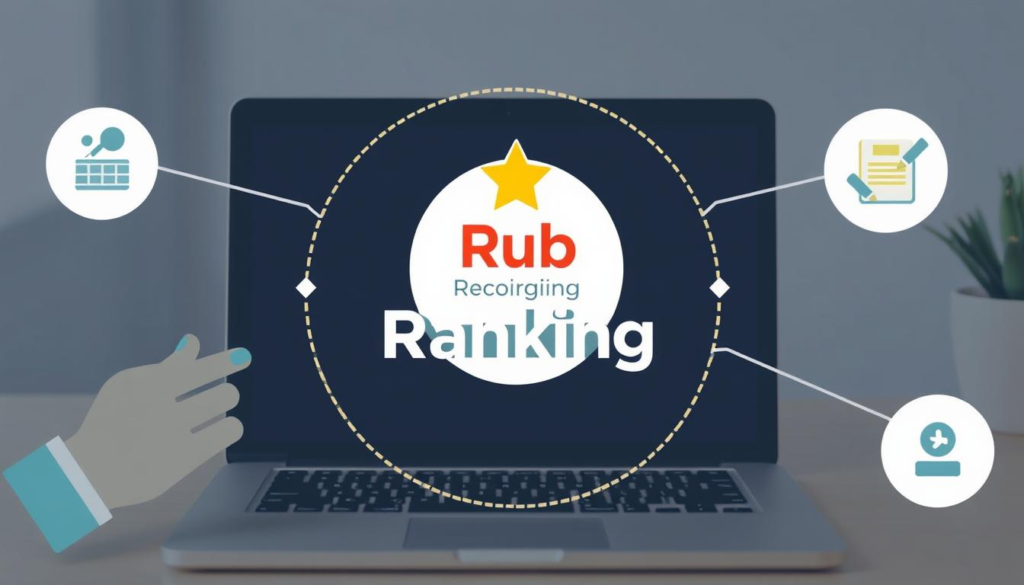In a world increasingly driven by data and metrics, ranking systems have become a cornerstone of evaluating and comparing different entities, whether they are individuals, organizations, products, or services. These ranking systems allow for a structured approach to making decisions, prioritizing actions, or assessing performance. One such ranking system that has garnered significant attention in specific sectors is “Rub Ranking.” This term, though not universally known, is used in various fields to assess, rank, and categorize entities based on a set of predefined criteria. This article explores the concept of Rub Ranking, its applications, its importance, and its evolving role in industries such as education, business, sports, and even technology.
What is Rub Ranking?
At its core, “Rub Ranking” refers to a ranking system or methodology where entities are evaluated according to a specific set of rubrics or criteria. The word “rubric” itself originates from the Latin word “rubrica,” which means “red,” referring to the instructions or guidelines traditionally written in red ink. In contemporary usage, rubrics are detailed frameworks used to assess the quality of something based on defined standards. Rub Ranking, therefore, is the process of ranking individuals, products, services, or other entities based on how they measure up against a set of structured criteria or rubrics.
The term Rub Ranking may not be widely recognized in mainstream discourse, but its application is most commonly found in settings where assessments or evaluations require a high level of objectivity and precision. These fields include education, business performance, sports analytics, and technology, among others.
The Evolution and Origins of Rub Ranking
Rubrics themselves have been in use for centuries, particularly in educational contexts. Teachers and educators have used rubrics to provide clear guidelines for grading student assignments. Over time, this practice evolved, and the application of rubrics to rank entities, such as academic institutions, corporations, or sporting teams, gained traction. Today, Rub Ranking is used to compare performance across multiple entities based on the same evaluative criteria.
While Rub Ranking has gained momentum in academic contexts, it is also increasingly utilized in industries such as business, sports, and technology, particularly when there’s a need to make data-driven decisions. The key to its effectiveness is the consistency and transparency it provides in comparison. By breaking down performance into distinct components and assigning scores or rankings based on each element, Rub Ranking allows for a more nuanced and informed understanding of an entity’s strengths and weaknesses.
The Core Components of Rub Ranking

Rub Ranking systems rely on several key components, which are vital for ensuring consistency, fairness, and accuracy in the ranking process. These components include:
1. Clear Criteria for Evaluation
The backbone of any Rub Ranking system is the criteria or rubric used to evaluate entities. These criteria can vary greatly depending on the field and what is being assessed. For instance, in education, the criteria might include factors such as clarity of argument, depth of analysis, organization, and use of evidence. In sports, it could include statistics like goals scored, assists, or defensive performance. A Rub Ranking system requires these criteria to be specific, measurable, and relevant to the domain.
2. Objective Scoring System
For Rub Ranking to be effective, it must use an objective scoring system. The evaluative criteria are typically assigned a point scale, where each entity is assessed against these criteria, and a numerical value is assigned. The scores are then aggregated to produce an overall ranking. This ensures that the ranking is not based on subjective opinions but on quantifiable measures.
3. Standardization
To maintain fairness and consistency, Rub Ranking systems are usually designed to be standardized. This means that all entities being assessed must be evaluated based on the same criteria, scoring systems, and measurement standards. Standardization helps eliminate biases and ensures that comparisons between different entities are valid and equitable.
4. Transparency
A key feature of Rub Ranking is transparency. Since the ranking is based on clearly defined criteria and an objective scoring system, those being ranked can easily understand how their position was determined. Transparency is particularly important in educational and business settings, where stakeholders need to trust that the evaluation process is fair and unbiased.
Applications of Rub Ranking in Different Fields

Rub Ranking has found widespread applications across various industries and domains. Each field adapts the system to suit its unique needs and objectives. Below are some of the most notable applications of Rub Ranking:
1. Education
In education, rubrics have long been a vital tool for grading and assessing students’ work. Teachers use rubrics to break down assignments, projects, and exams into specific components, each with a set of criteria and performance levels. Students are then ranked according to how well they meet the expectations of these criteria.
However, Rub Ranking extends this concept beyond individual student assessments. It is used in ranking schools, universities, or academic programs based on a set of criteria such as academic performance, faculty qualifications, research output, and student satisfaction. University rankings like those provided by U.S. News & World Report and QS World University Rankings are examples of Rub Ranking in action, where institutions are ranked based on a predefined set of rubrics in areas such as teaching quality, student outcomes, and international diversity.
2. Business and Corporate Performance
In the business world, Rub Ranking is used to evaluate and compare organizations or business units based on performance metrics. For instance, businesses might rank competitors or suppliers according to criteria such as financial stability, market share, customer satisfaction, or innovation. Similarly, companies may use Rub Ranking to assess internal departments or teams on their efficiency, productivity, and alignment with strategic goals.
Some well-known corporate rankings, such as the Fortune 500 and Forbes Global 2000, apply Rub Ranking principles to assess the largest and most influential companies in the world. These rankings are based on a set of financial and operational criteria, providing a clear picture of a company’s standing in the global market.
3. Sports Analytics
In sports, Rub Ranking is an essential tool for assessing team and player performance. Traditionally, rankings such as league tables in football or basketball have been based on win-loss records. However, more advanced Rub Ranking systems now use a wider range of performance indicators, such as goals scored, assists, defensive metrics, efficiency ratings, and even psychological factors like player resilience.
In addition to league rankings, Rub Ranking is used to evaluate players in fantasy sports leagues, player recruitment, and even sports betting. Teams may use Rub Ranking systems to decide which players to draft or trade based on a composite score derived from various performance indicators. For example, in basketball, a player might be ranked not only for scoring but also for passing accuracy, defensive contributions, and leadership qualities, all of which are assigned specific weightings.
4. Technology and Software Development
In the technology sector, Rub Ranking is often used to assess software or technological products against a set of evaluation criteria. For instance, software solutions might be ranked based on factors like user-friendliness, functionality, security, scalability, and customer support. These rankings help consumers and businesses make informed decisions about which products to purchase or adopt.
Rub Ranking is also applied in the evaluation of tech companies or startups. Analysts might rank tech firms based on innovation, market share, and growth potential. This process provides investors with a clearer understanding of the companies’ prospects and helps consumers select the best technology solutions based on their needs.
5. Entertainment and Media
Rub Ranking is also widely used in the entertainment industry, particularly in movie, music, and video game reviews. Critics and audiences alike use rubrics to evaluate films, albums, and video games based on a range of criteria such as plot, acting, cinematography, originality, and audience engagement. Review platforms like Rotten Tomatoes and Metacritic apply Rub Ranking systems to provide aggregated scores for movies, TV shows, and games, offering consumers a snapshot of critical reception.
Similarly, TV networks, music labels, and streaming platforms often use Rub Ranking to determine which shows, films, or songs to promote based on popularity, viewer ratings, or box-office performance. This helps them refine their content strategies and optimize audience engagement.
The Advantages and Limitations of Rub Ranking

Rub Ranking offers several advantages, including:
- Objectivity: By relying on clearly defined criteria, Rub Ranking minimizes subjective biases, leading to more fair and consistent evaluations.
- Transparency: Rub Ranking systems provide stakeholders with a clear understanding of how rankings are determined, fostering trust and credibility.
- Clarity: Entities being ranked can identify their strengths and weaknesses based on the detailed breakdown of performance criteria.
- Informed Decision-Making: Rub Ranking provides valuable insights that can inform decisions in a range of sectors, from education to business and technology.
However, there are also limitations to consider:
- Subjectivity in Criteria Selection: The choice of criteria and how they are weighted can still introduce a degree of subjectivity. For example, what is deemed important in one ranking system may differ from another.
- Complexity: For some entities, applying a Rub Ranking system may be overly complicated or resource-intensive, especially when numerous criteria need to be tracked and evaluated.
- Rigidity: Rub Ranking systems can be inflexible, focusing on a predefined set of criteria that may not fully capture the nuances of an entity’s performance.
Conclusion
Rub Ranking is a powerful tool for evaluating and comparing entities across a wide range of sectors. Whether applied to education, business, sports, or technology, Rub Ranking provides a structured and transparent way to assess performance based on predefined criteria. As the world continues to rely on data-driven decision-making, Rub Ranking will likely play an even greater role in shaping the way we measure success and make informed choices. While there are challenges in implementing and interpreting Rub Ranking systems, their advantages in terms of objectivity, clarity, and fairness make them an invaluable tool for modern assessments.

